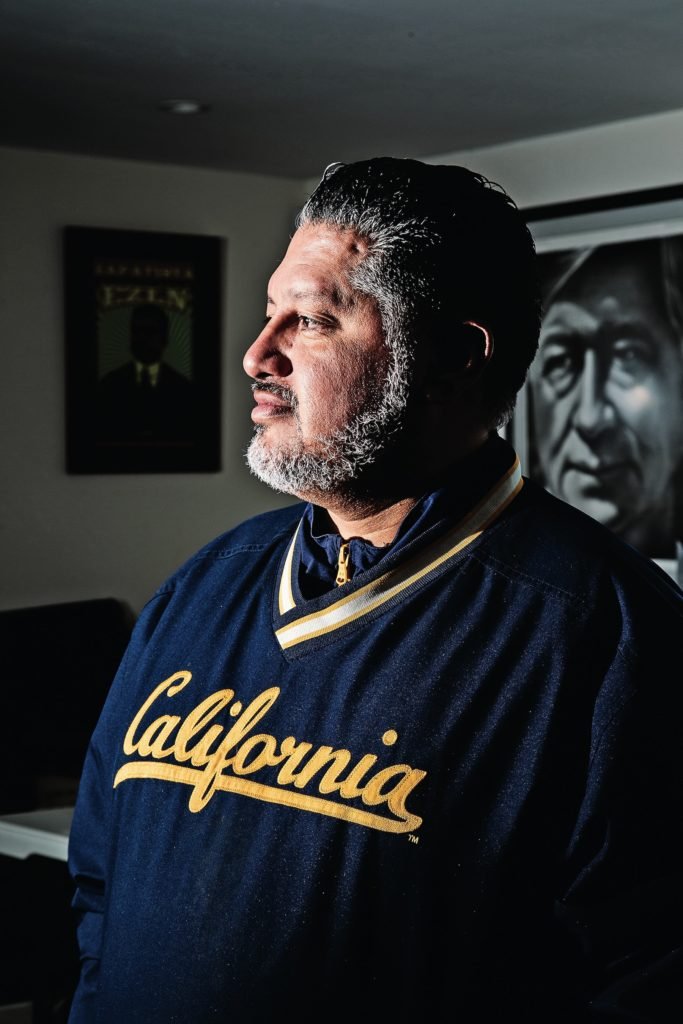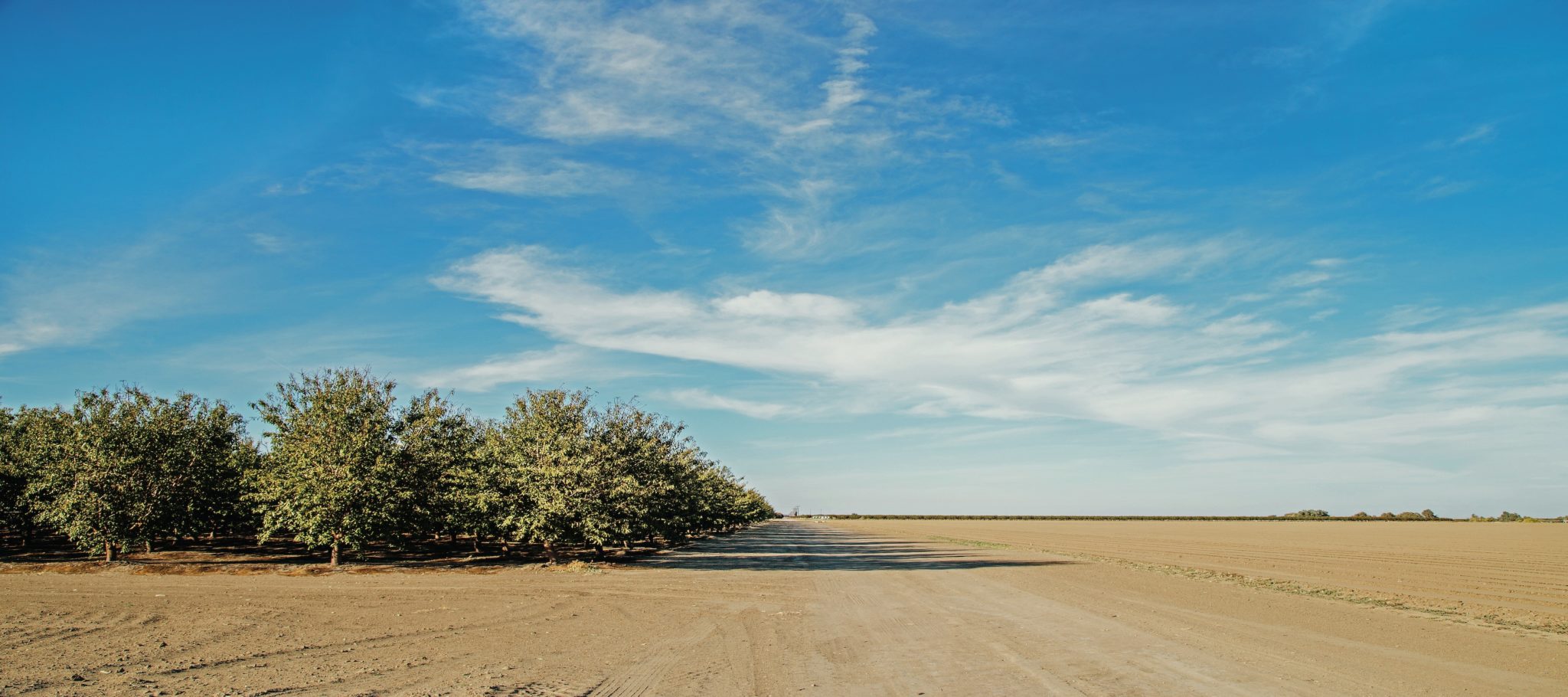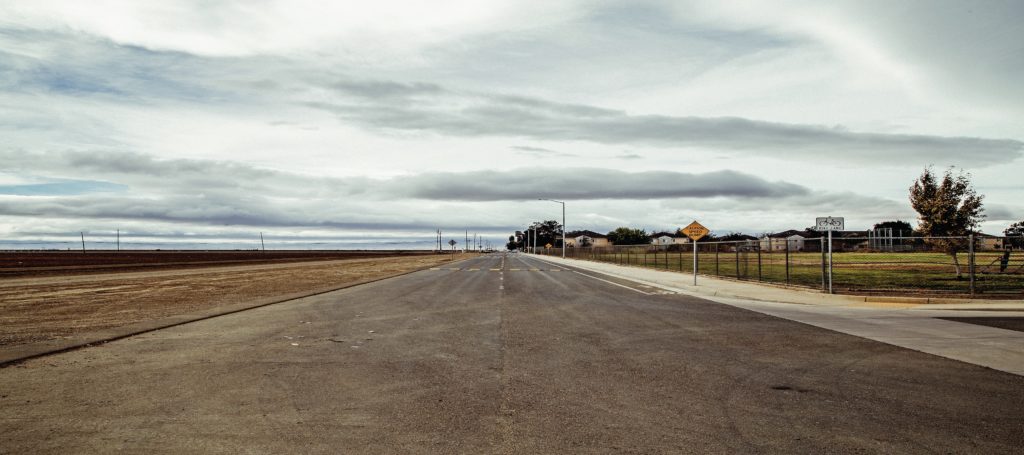Rey León and I drive down an arrow-straight stretch of two-lane asphalt northeast of Huron, in Fresno County, on the western side of the San Joaquin Valley. On one side of the road is a vast cotton field, the bolls white and fat, ripe for the harvester; on the other is a regiment of solar panels covering multiple acres.
León, 49, is mayor of the predominantly Hispanic town of Huron—Pop. 7,000, and considerably larger during harvest season. He’s also an environmental activist and social justice advocate, not to mention a highly informed and charismatic raconteur. His stories of growing up in this hardscrabble farmworker community, of making it to UC Berkeley and returning to his hometown after graduation, are by turns dramatic and amusing, and seemingly always in service of some political point he wants to make.
“Check it out,” says León, pointing first to the cotton, then the solar array. “The present and future of the San Joaquin. Solar energy is big and getting bigger here. They’re making a lot of money, but that’s not trickling down to the people who live in Huron and work in these fields. So, one of the things we’re developing is a solar microgrid and storage project for the city. We’re going to have our own solar-based utility that will provide us with the energy we need, and the means for selling excess power to PG&E or any private facility that needs it.”
Among those potential customers, of course, are the agricultural enterprises that drive the economy and define the culture of the San Joaquin Valley—a 920,000-acre food-and-fiber dynamo that produces more than $2.6 billion annually.
It once was said of Chicago’s meatpacking district that every part of every butchered hog was utilized except the squeal. That same efficiency is evident here in the San Joaquin. In the sprawling processing plants scattered among the valley’s thousands of acres of nut orchards, huge piles of almond hulls—the leathery husks that cover the shells—lie drying in the early autumn sun. They’re not waste: local farmers pay $150 a ton for the hulls to feed to their dairy cows, which relish them for the high sugar content. The almond shells themselves have value as well: they’re converted to a high-grade activated charcoal much in demand for water purification.
“We grow almonds, pistachios, some wine grapes, garlic, a little cotton—and we rotate grains in some areas that can be dry-farmed,” says Stuart Woolf, a slim man who is burned brown by the sun and favors jeans and scuffed boots, the veritable uniform of farmers in the region.

Woolf, 62, is a second-generation San Joaquin Valley grower whose family farms 20,000 acres, mostly in the western San Joaquin, and owns and operates a large tomato processing facility just outside Huron.
He and León both grew up in the western San Joaquin, though on opposite sides of the economic divide. The two men know—and, to a real degree, like—each other. And while they are focused on different problems, they both know and accept that dramatic changes are under way and that the valley of tomorrow will be very different from the valley of today.
Woolf says the crops he grows are not unique to the San Joaquin Valley—but their scale and yields are. “We grow between 60 to 70 percent of the world’s pistachios, 80 percent of the world’s almonds, and 93 percent of the nation’s processing tomatoes. That’s due to several factors. First, we’re in the right latitude for these crops. We also have ideal Class 1 soils, a combination of sand and clay. And the geographic configuration of the area creates a high-pressure dome over the valley, functionally turning it into a giant greenhouse.”
And—until recently, at least—the West Side also had abundant water, thanks to government irrigation projects. This area that Woolf’s father helped to develop into an agricultural powerhouse was founded on water deliveries from the federal Central Valley Project, the massive complex of pumps and aqueducts that shunts water from the Delta to farms and cities south. Now, however, relentless drought that climatologists link to the warming planet has forced a sharp curtailment of water deliveries. Farmers in the San Joaquin have made up the shortfall by pumping groundwater, but this brings its own problems (see sidebar) and only provides stopgap relief. All through the valley—particularly on the west portion—water tables are dropping precipitously.
Some analysts think the region may ultimately wither away, its now expansive plantings disappearing into memory, the land reverting to tumbleweed, starthistle, and jackrabbits. Others, like León and Woolf, acknowledge that profound change is coming, but are confident that the people and industries of the West Side will adapt and even thrive. Like the mayor, Woolf too is a proud Cal alum, having earned a bachelor’s in political economies of industrial societies in 1982, and, like León, he has been known to blurt “Go Bears!” only half ironically. But while they generally concur on the nature of the economic challenges facing the San Joaquin Valley, they represent different constituencies, and they—mostly—advocate different responses.
One thing both men can agree on: notwithstanding the myriad signs one sees posted in dusty fields up and down Interstate 5 demanding new dam construction, extra surface water storage alone won’t save San Joaquin agriculture in its present form. Virtually all the major rivers on the west slope of the Sierra—the region’s primary source for surface water—have been dammed already, and building new reservoirs on the few remaining candidate sites would yield relatively small gains for very large outlays. In any case, more storage only helps if you get more rain. Climate models predict the opposite—more and deeper droughts. In the Golden State of the future, low reservoirs will likely be the norm. This portends secular changes—i.e., gradual, long-term shifts—in how, where, and what growers plant.
Woolf is concerned but hardly shocked; he’s seen changes before. “Cotton was king here for a long time. At one point, the valley had about 1.25 million acres under cultivation. Now it’s about 250,000 acres.” Cotton was excoriated for its high water demands, a charge now levied against the valley’s current glamour crop: almonds. “Almonds are even more water intensive than cotton, and as you see water availability tighten, growers will reduce their plantings accordingly,” he says. Currently, there are about 1.5 million acres of almonds in the state, and Woolf estimates that the area may see 150,000 or more acres taken out of production in coming years.
Almonds won’t disappear from the state altogether, Woolf stresses, because they’re worth a lot of money. Growers receive $3 a pound for “nonpareils,” the best grade, and growers can harvest more than a ton per acre on irrigated ground.
The farmer who survives is likely to be a genuine farmer; that is, someone who lives on or near their land, manages it personally and has deep roots in the local agricultural community—as opposed to a hedge fund manager in New York who just looks at the spreadsheets each quarter.
“Growers will use the water they do have to grow almonds on the land best suited for them,” he says. “That still means that farmers are going to have to fallow a lot of land, of course. In fact, we already have fallowed a lot of land.” To fallow is to leave unsown and, by logical extension, unirrigated. “Right now, one of my primary concerns is figuring out how to derive maximum value from the lands I don’t irrigate. Every other grower will have to do the same over time, or they’ll be out of business.”
That’s going to take site-specific, complex planning. The old way of doing things—managing a simple, lavishly irrigated monocrop covering thousands of contiguous acres—simply won’t cut it. The farmer who survives is likely to be a genuine farmer; that is, someone who lives on or near their land, manages it personally, and has deep roots in the local agricultural community—as opposed to a hedge fund manager in New York who just looks at the spreadsheets each quarter.
As the drought has deepened in the state, growers have turned to groundwater, resulting in severe overdraft in many areas—particularly the San Joaquin Valley. That led to the passage of the 2014 Sustainable Groundwater Management Act (SGMA), which required the identification of the state’s overdrawn and at-risk basins, quantification of their yields, and the development of pumping plans that achieve sustainability within 20 years of being implemented. With Central Valley Project water in doubt, Woolf is looking to SGMA to redefine the parameters of his future.
“We already know that our sustainable pumping figure during drought is .69 acre-feet of water per acre.” (An acre-foot is the amount of water it would take to cover one acre of land in a foot of water.) “We can take that much without overdrafting,” says Woolf. “That will pretty much determine what we plant and where.”

Many of Woolf’s West Side almonds will come out through simple attrition. Almond trees are only commercially productive for about 20 years, and his groundwater plan means replacement trees won’t be planted in many areas. Instead, Woolf will concentrate on growing tomatoes for processing, as well as pistachios, which are longer-lived and less thirsty than almonds.
“Right now, we have 2,500 acres of pistachios on our Huron ranch, and I want to have a minimum of 2,500 acres of tomatoes,” he says, noting that tomato acreage requires a large ancillary complement of reserve land because tomato fields must be fallowed and rotated to prevent the buildup of diseases. “We still like almonds, of course, but we’re looking farther north. We have a couple thousand acres near Chico, where there’s much more available water.”
Woolf is also experimenting with alternative crops—specifically, drought-tolerant ones like agave, the feedstock for products like tequila and mezcal. “The ultimate goal would be to distill and market spirits ourselves, under our own brand,” he says.
Another goal: investing in a water bank. “In wet years, the San Joaquin River and its tributaries can have very high flows,” says Woolf. “We can divert some of that water to porous ground so it can percolate down to our aquifers, creating an ‘account’ we can later pump and use.”
And there’s a new crop on the horizon: energy. Rather than asking his plants to turn sunlight into calories, as farmers always have, Woolf plans to harvest sunlight directly. He’ll ultimately convert 3,500 acres of former cropland to solar installation, and many other growers are doing the same: Large photovoltaic arrays are popping up all across the valley.
Some environmental advocates are pushing the trend, hoping to convert most of the West Side into a massive solar farm and diverting all the water currently used for irrigation to cities, wildlife, and fisheries. That may sound attractive, but Woolf says it doesn’t pencil out. Farmers still stand to make more harvesting high-value crops like almonds than they do reaping electrons. “For another thing, we’d maybe need 500,000 acres of solar panels to meet California legislation requiring a zero-carbon energy supply by 2045,” he says. “That’s a lot less acreage than will be fallowed due to SGMA, not to mention all the panels that are going up on homes.”
In any case, a bigger issue, says Woolf, “is storage—practical and cost-effective methods for storing the energy so it can be used when the sun isn’t shining.”
The natural world is merciless, though not in a malign way; it simply doesn’t care. Farmers understand that, and the successful ones, like Woolf, have learned to accommodate themselves to nature’s extremes. “If anything will assure our survival, it’s our ability to identify and accept long-term trends, diversity in our operations, and a willingness to swim with the tide,” says Woolf. “You have to keep swimming.”
A few miles northeast of Woolf’s headquarters, Rey León ponders the same dilemmas of drought, water scarcity, and land retirement. Along with his mayoral position, León also is the executive director of the LEAP Institute, a West Side social equity group. Like Woolf, he is an optimist. He’s also intent on affecting meaningful socioeconomic change, something he makes clear during his show-me drive through Huron and its purlieus.
“Look at all this richness,” he says. “These almond trees supply the world. If you eat pizza, you’ve eaten a lot of Huron tomatoes. This, all this, is bringing in incredible revenues to this area. But very little of it reaches the people who make it possible—the people who work in agriculture. And we need to change that.”
The son of immigrants from Michoacán, Mexico, León grew up with seven siblings in Huron. Throughout his childhood, he worked after school at his parents’ restaurant. “There were a lot more seasonal farmworkers back then,” he says. “My mom would get me up before dawn to pack lunches for the guys heading out to the fields. During the lettuce season, this town would swell by 8,000 people. Everybody here would rent out their spare rooms, even their garages. Things were busy.”
Lettuce isn’t a big crop here anymore, and automation in general has slashed the number of workers needed around the valley. Take tomatoes, for instance. “On the produce harvesters, you’d typically have a crew of 15 to 18 people,” he says. “You’d need one guy to drive the harvester, another to drive an accompanying tractor, and 12 to 15 sorters on the harvester. Now all you need is three—a harvester driver, the tractor driver, and a guy who monitors the computer doing the sorting and packing.”
There’s still work, of course—pruning the almond orchards during the winter and working in the tomato and nut processing plants—just not as much as there used to be. The main connection between the old Huron and the current one is poverty. Except there’s more of it now. Most of the storefronts in towns are shuttered, their interiors dark and cavernous.
León drives by a near-derelict house. “That’s where Cesar Chavez used to meet people when he was organizing around here,” he says. Then he passes a series of low, ramshackle buildings that look like chicken coops. It’s a labor camp, where farmworkers rent small single rooms for $300 a month. The kitchen and bathroom facilities are centralized, and the walls look near collapse. A woman stands next to one of the buildings with a hamper in her arms, an opaque expression on her face, gazing into the distance.
He’s determined to get in on the solar boom—both for his microgrid project and as an employment source for Huron residents.
León became involved in community organizing while still at Cal, launching and managing annual health fairs at Huron. He found he had a knack for activism, and won when he ran for mayor in 2016 against the long-standing incumbent. Whether as mayor or leader of the LEAP Institute, he and his colleagues are highly adept at securing grants and have been able to acquire millions in funding for an impressive list of initiatives. They include: a new bridge spanning a creek on Highway 269 that can flood dangerously (as it did in 1995, when six Huron residents died trying to negotiate the crossing); a vanpool for farmworkers to take them to and from their jobs, saving each laborer hundreds of dollars annually; a number of EV chargers for vanpool vehicles and residents’ cars; and a downtown tree-planting project and extensive street repairs. But he’s just getting started, he says: the list of planned initiatives is long and includes a proposed nature preserve on 3,000 sparsely forested acres north of town.
With only a few parks in Huron, “this will provide us with employment and educational and recreational opportunities,” he says. “There are a number of listed species here—burrowing owls, spadefoot toads, Swainson’s hawks—and that will allow us to acquire conservation funding. The same goes for carbon sequestration—we’re going to get support for an ambitious tree-planting effort. We also want to see a youth employment component for trail construction, habitat restoration, and docent programs. This reserve is really going to make a huge difference in the quality of our lives.”
León is also looking to work with local landowners to launch a 200-acre hemp initiative on leased land. “That’s hemp, not cannabis,” he emphasizes. “You use it for fiber and seed oil, not smoking. We want to both grow it and process it, creating different value-added products and good-paying jobs for locals.”
And, as noted, he’s determined to get in on the solar boom—both for his microgrid project and as an employment source for Huron residents.
“That reminds me,” he says during his tour, pulling over near a particularly large solar array. “The guy who’s involved in this project has been avoiding me. He always calls me when he wants something, but he doesn’t call back when I need something.” He speed-dials a number on his mobile, and voicemail kicks in. “Hey,” he barks. “It’s Rey. I need you to call me on that thing we talked about. Get back to me, man.” He pockets his phone.
“I’ve been pitching a training program to him,” León explains. “There are a lot of jobs, good jobs, in solar. And there is absolutely no reason the companies can’t bring our young people into the industry. There’s no need to import workers. We’re here and we’re ready. All we need is commitment from the companies and the training.”
León acknowledges there’s a bright green thread that runs through most of his priorities: nature preserve, hemp, solar, tree-planting, and EV vanpools. “I want to make sure Huron has access to fair and equitable blue-collar and white-collar employment,” he says, “but blue or white, the jobs also have to be green. An extraction-based economy—of water, of soil, of labor—can’t be sustained. Any possible future for us has to be sustainable.”
Which brings León to his most pressing priority. Green and high-tech jobs are skilled jobs, he notes, so education is key. Huron has a decent elementary and middle school, but high schoolers have to travel an hour or more by bus to Coalinga, a larger community to the west. León is determined to build a high school in Huron—and he has enlisted fellow Cal alum Stuart Woolf in the project.
“Stuart gave us 50 acres of his land for the campus,” León says, “so we have our site, and we’re getting the funding together. That donation from Stuart really clinched the deal. I told him we’re going to make the wolf the school mascot in his honor, and I meant it. You know, León means ‘lion’ in Spanish. That’s a good partnership: Wolf and Lion. So, yeah, Go Bears!”
Glen Martin is a longtime contributor to California.
Clara Mokri earned her M.J. in documentary film at Berkeley’s Graduate School of Journalism, where she received the Dorothea Lange and Jim Marshall Fellowships. Her work has appeared in the New York Times, TIME, and Mother Jones, among others.





















